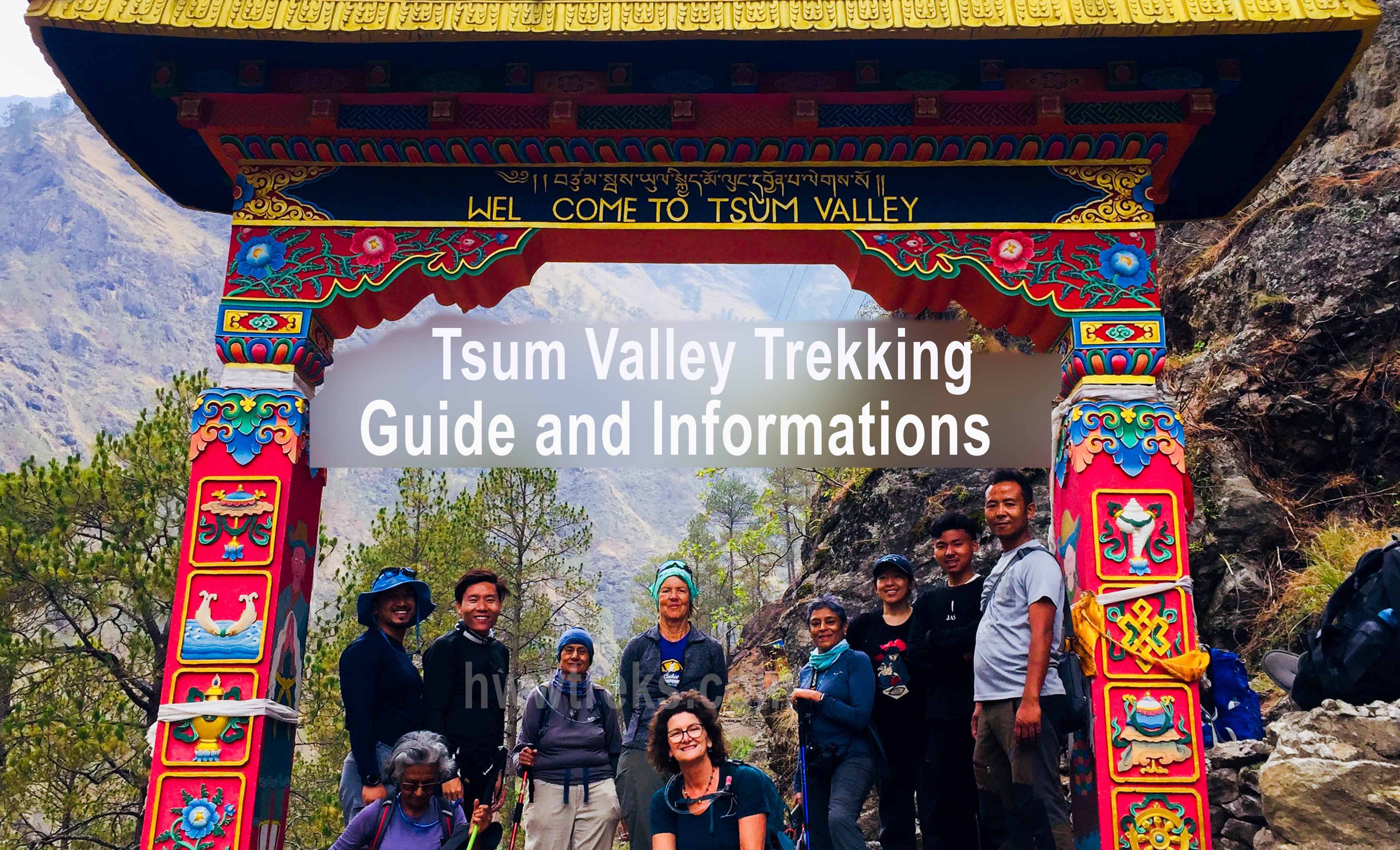
- 03/17/2023
- Tags: Tsum Valley
- Himalayan Wander Walkers
Tsum Valley trek
Tsum valley is a sacred and isolated valley that is hidden within the soaring snowy mountains of Ganesh Himal, Sringi Himal, Buddha Himal, and Himal Chuli in the east of the popular circuit trek of Manaslu Larke Pass. In the local language ‘Tsum’ means Vivid. It is also known for Beyul Kyimolung which means a secret valley found by people with pure minds and hearts. Locals believe that this magical valley is created by Tantric Master, Guru Rinpoche who introduced Buddhism in Nepal, Tibet, and Bhutan during the 8th century.
Tsum valley trek was a restricted area of Gorkha district until 2008 when it was opened for trekking for the first time. This secluded valley is visited by many foreigners from Finland, Australia, Canada, and United State in 2009 and became one of the most popular trekking destinations in Nepal for all trekkers from different nations. This valley of Tsumpa, ethnically Tibetan inhabitants is rich in all kinds such as magnificent mountains, Tibetan living culture, ancient Buddhist monasteries, green vegetation, fertile land, blue sheep, and Himalayan Vultures. Trekking to Tsum valley provides you an opportunity to experience the daily lives of Buddhist nuns, monks, and even the ordinary Tsumpas by spending quality time with them during your trek.
Besides trekking, Tsum valley is also a sacred pilgrimage site of Milarepa, Tibetan Yogi. In Tsum valley there are numerous caves and monasteries that are used for meditation by Milarepa in ancient times. Tsum valley trekking package.
"Tsum Valley is the perfect blend of Nature, Culture, Spirituality, and adventure." Alexander, New York
Are you Planing your trekkig to Tsum Valley and need help?
Contents [show]
How to Get Tsum Valley?
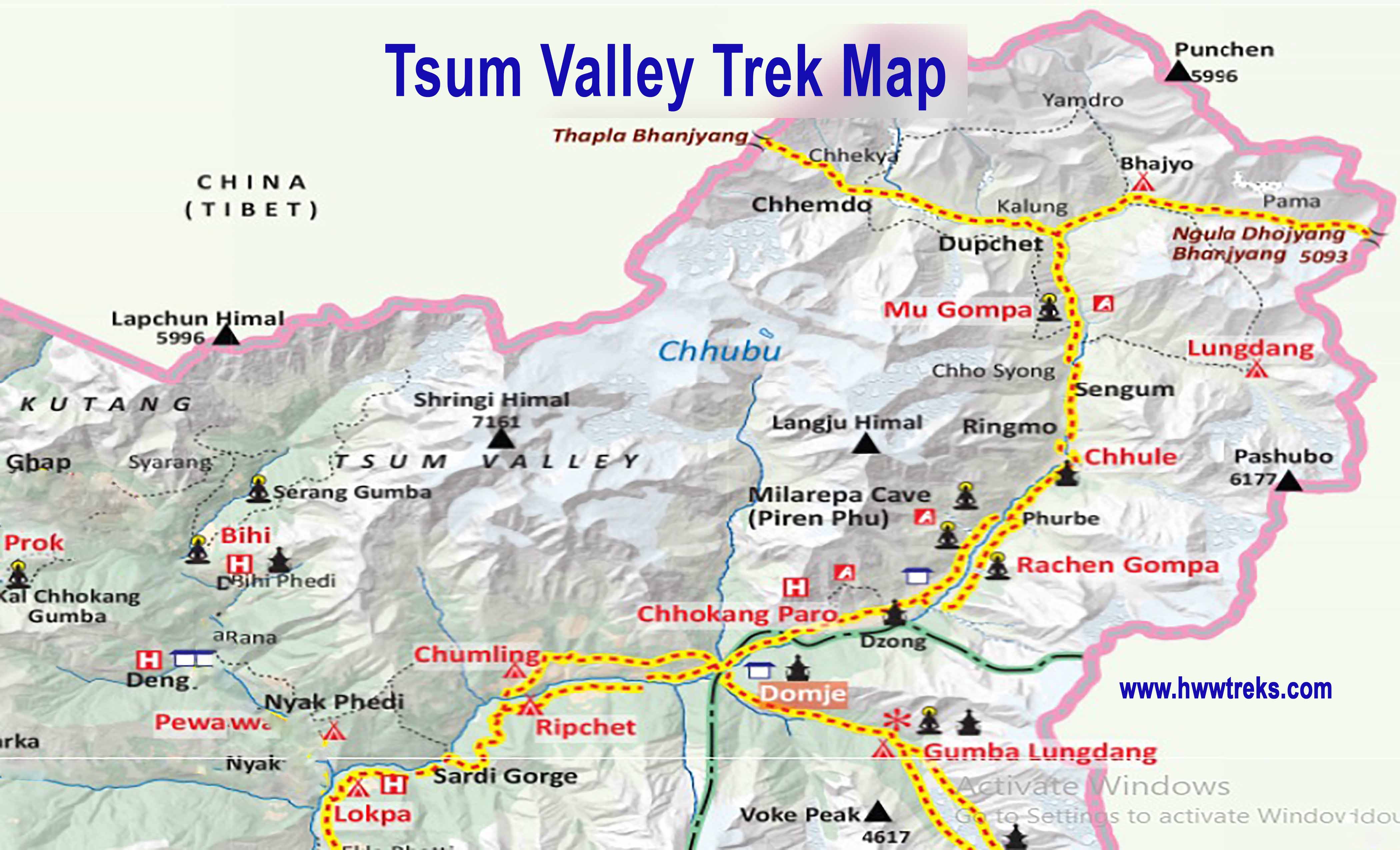
Driving from Kathmandu to Machha Khola is the only option to get there which covers a distance of 140 kilometers approximately. A few years back the road was connected to Soti Khola and the trek started from there. But now due to the extension of the road to Machha Khola, the trek starts only from Macha Khola and it saves one day for your trek. From Macha Khola, the trek route continues on the same trail of Manaslu Larke La Pass Trek until Ekle Bati. After a few minutes of walking, there is a junction with the suspension bridge and direction board. The bridge will lead you to Manaslu Larke La Pass and the way to your right side continues to Lokpa village of Tsum Valley. Now you are officially entering the sacred valley of Tsumpa, Tsum valley.
Tsum Valley Trekking Permits and their Cost
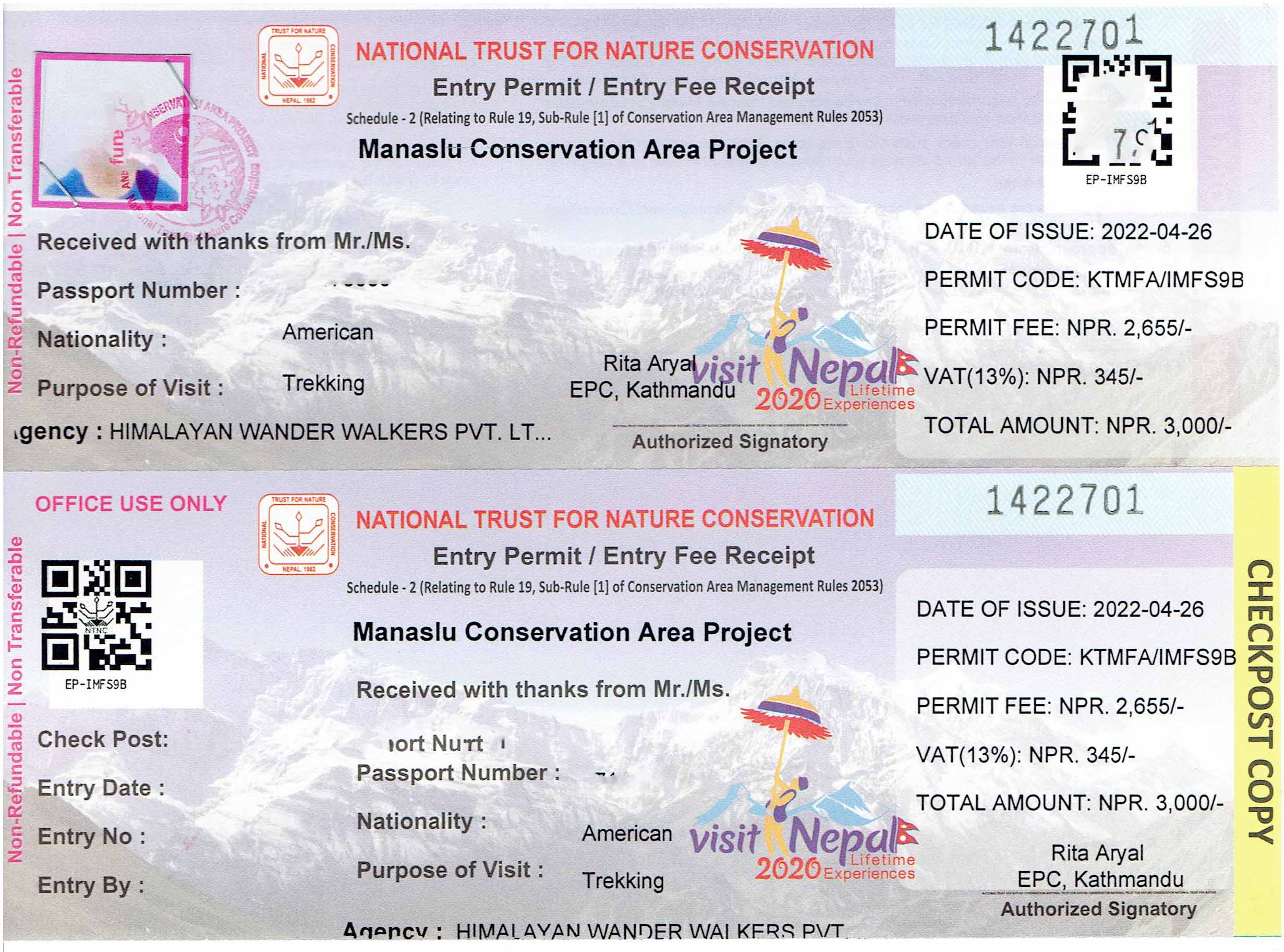
Tsum Valley required only two permits for trekking. They are Tsum Valley Restricted Area Permit (RAP) and Manaslu Conservation Area Project (MCAP). Remember it is mandatory to have at least two trekkers to get the RAP from the Department of Nepal Immigration. Trekking permits for Tsum Valley are only obtained through authorized Nepalese trekking companies. The cost of MCAP permit remains the same for all season but the restricted area permits varied from high season to low season and of course number of trek days.
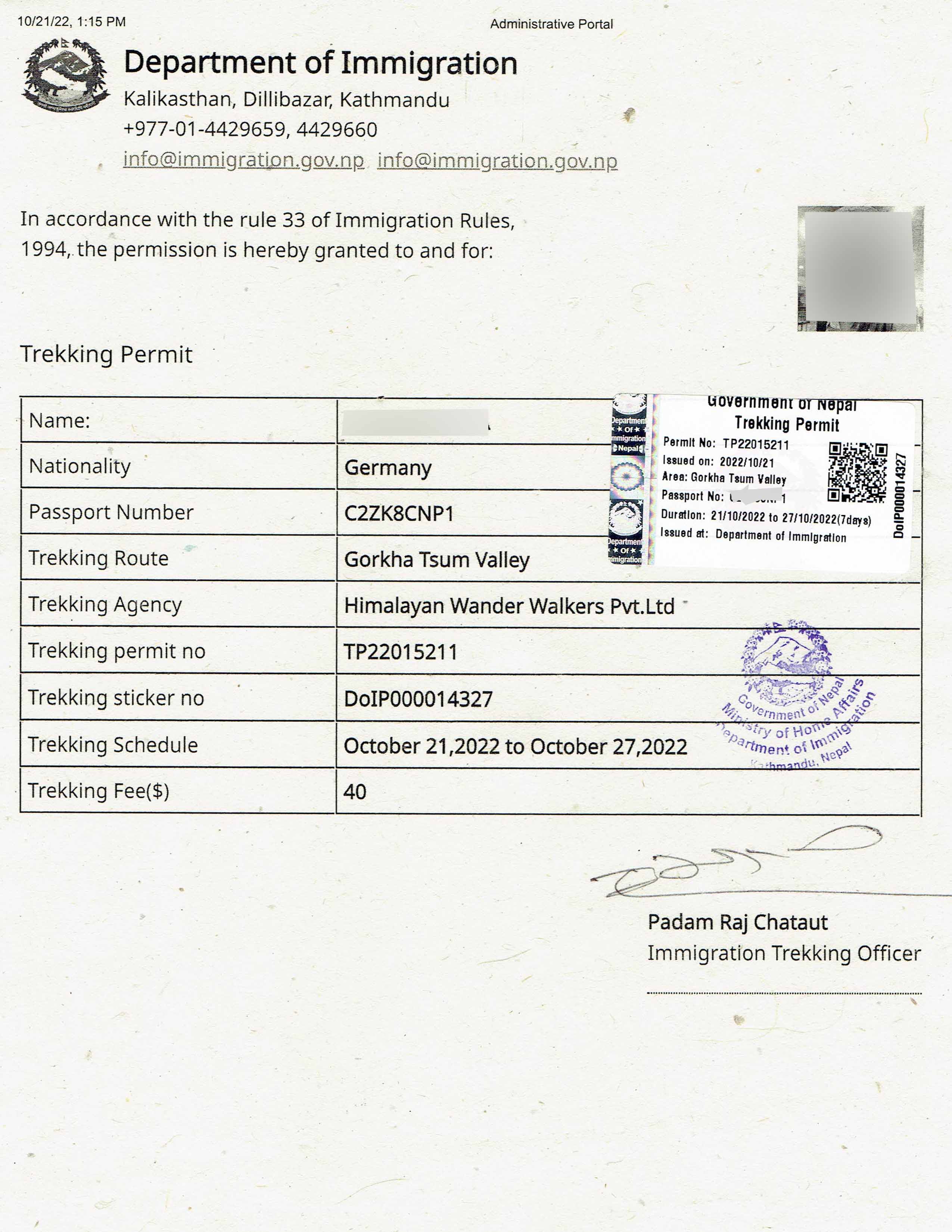
Tsum Valley Restricted Area Permit (RAP) cost USD 40 for the first week during the month of September to November. If you are spending more days than a week, the additional per day cost USD 7. The fee for RAP will be less from December to August which cost USD 30 for the first week. An extension or additional permit thereafter is USD 7 per day. The second permit that you need for trekking in Tsum valley is Manaslu Conservation Area Permit (MCAP) which cost which costs about USD 30 (NPR 3000) for foreigners and USD 10 (NPR 1000) for SAARC.
How you can obtain your Restricted Area Permit for Tsum Valley?
To obtain your Tsum Valley permits you to need to email us the following documents to our mailing address: info@hwwtreks.com
- A clean copy of your valid passport (if you already got a visa then send a copy of your Nepal visa too)
- Copy of your visible passport-sized photo (taken within the last 6 months)
- International Flight Tickets for Nepal
- Copy of your travel Insurance
- Hotel Booking if you booked by yourself (Optional)
After receiving all your required documents for RAP we will get your Permits on time.
Best and Recommended itinerary for Tsum valley trek

13 days Tsum valley trek from Kathmandu is a highly recommended itinerary that is not more nor less to explore all the remarkable places that lure trekkers and visitors. This trek can be done in a minimum of 10 days if you wish to return to Kathmandu by chartered helicopter. If you are physically fit and have enough time to trek further then you can also continue to the Manaslu region for a combined trek of 21 days Tsum Valley and Manaslu circuit trek.
13 Days Tsum Valley trek Itinerary
Day 01: Drive Kathmandu to Machha Khola (870m), 8-9 hours
Day 02: Trek from Machha Khola to Jagat (1340m), 6-7 hours.
Day 03: Trek from Jagat to Lokpa (2240m).
Day 04: Trek from Lokpa to Chumling (2386m), 5-6 hours.
Day 05: Trek from Chumling to Chhokangparo (Upper Tsum) (3010m), 3 hours.
Day 06: Trek from Chhokangparo to Nile (3361m) visit Rachen Monastery on the way
Day 07: Trek from Nile to Mu Gompa (3700m) 3 hours
Day 08: Trek from Mu Gompa to Chhokangparo, visit Milarepa Piren Phu Cave on the way (6-7 hours)
Day 09: Trek from Chhokangparo to Gumba Lungdang (3200m), 5-6 hours
Day 10: Trek from Gumba Lungdang to Ripchet (2470m), 4-5 hours
Day 11: Trek from Ripchet to Philim (1570m), 5-6 hours
Day 12: Trek from Philim to Machha Khola (869m)
Day 13: Drive back from Machha Khola to Kathmandu
View detail of Tsum Valley Trek
Trekking guide and Porter for Tsum valley

Trekking Guides and porters play a vital role in any successful treks in the Himalayas of Nepal. Guides and porters are the real heroes of the Mountain who are famous for their sincere and hardworking job in the high altitudes.
Tsum valley is a restricted area that needs a guide for all trekkers as it is mandatory by tourism rules and regulations of the Nepal government. In general, hiring a guide in the Himalayas is always safe and has many benefits. Trekking with a local guide without any hassle is the main reason why many trekkers prefer to take a guide on the mountain. It is obvious that you will be more comfortable, informative, and secure on all sides during your trek.
Porters for the Tsum Valley trek are preferred by many trekkers but still, it is optional. Porters are the right choice for those who like to trek light and comfort. Trekking porters of Nepal have a unique nature of carrying heavy enough luggage for trekkers in the high altitude where there are thin and hard climbs. We provide one porter for every two trekkers with a maximum load of 10 kg from each trekker which is 20kg in total.
Himalayan Wander Walkers’ energetic and veteran trekking field team (guides and porters) are our most respected staff who are passionate and dedicated individuals. Our mountain heroes had sacrificed more than enough for leading your successful journey to the Himalayas. We have our own local guides and porters who are originally from Tsum Valley. Meet our Team.
Best time/season for Tsum Valley Trek
In General, the spring and autumn seasons are the most favorable trekking time in Nepal. The rest two seasons of winter and summer are not recommended for trekking.
Spring season Trek in Tsum Valley
March, April, and May of the spring season is a peak trekking time for Tsum valley as the temperature gradually increases, and not yet a rainy season too.
Autumn Season Trek in Tsum Valley
September, October, and November are regarded as the best time for trekking in Tsum valley during the autumn season. The monsoon ends in late august and slowly the temperature of scorching summer will drop down which makes favorable weather for trekkers to visit the Himalayas.
In Tsum valley there are few trails that are very risky during the rainy season because of the heavy rain you may face trouble with landslides and stones falling. During mid-winter places above the Nile are mostly covered with snow and the tea houses will be closed. So, always choose the spring and autumn seasons for trekking in Tsum Valley.
8 Reasons to Visit and trek Tsum Valley
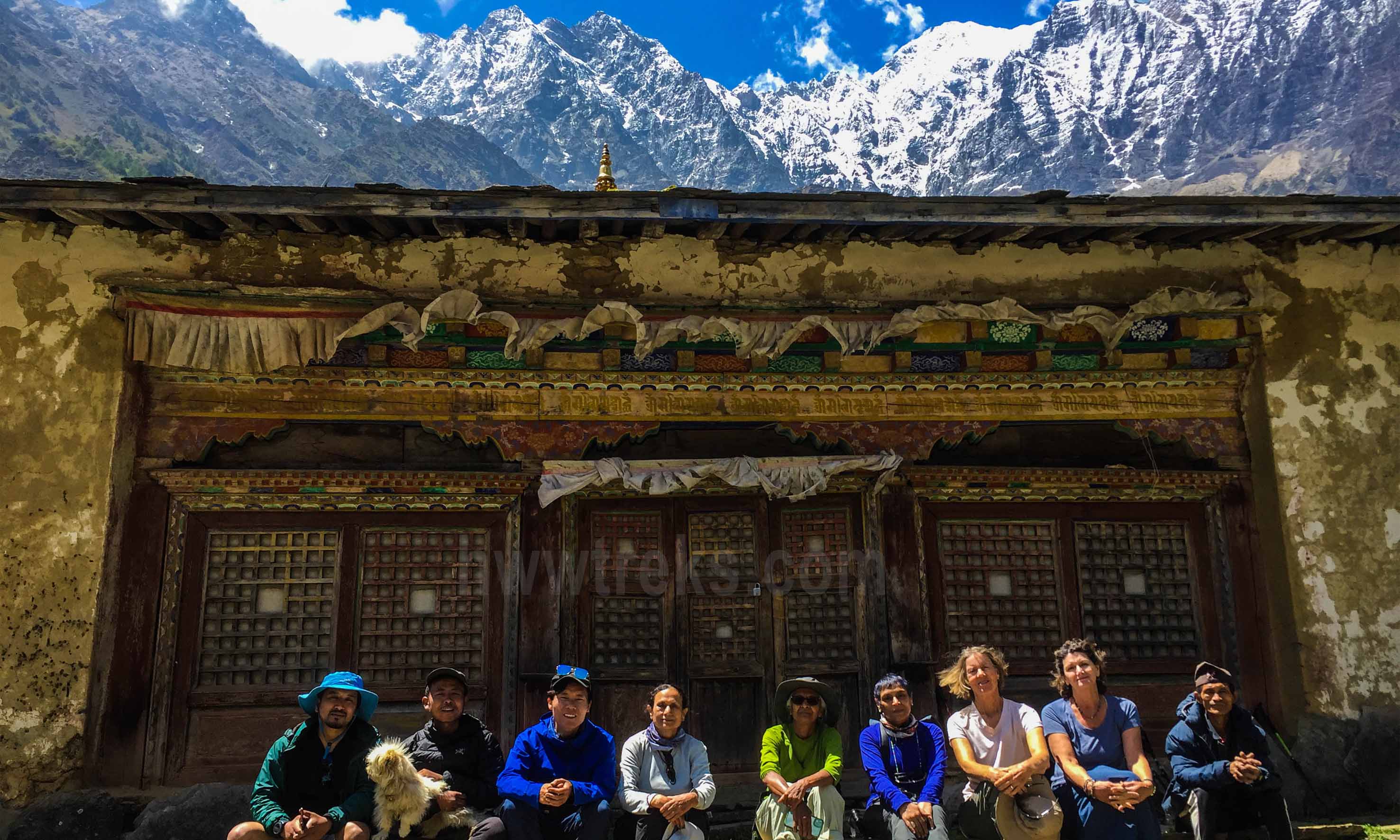
There are many reasons to visit Tsum valley. This less-explored valley is a hidden gem of the Gorkha district which offers an opportunity to discover and experience a different region from other parts of northern Nepal.
Although there are many reasons to visit Tsum Valley, here are 8 main reasons to choose Tsum Valley for trekking in Nepal.
- No Harming and Killing an animal
Tsumpa people do not harm nor kill animals in Tsum Valley. This does not happen recently, it's been already 102 years (considering this year is 2022). The act of protecting others is the root of happiness and peace, so the person doesn’t get the result of negative karma and has happiness in this and future lives. Tsum Valley is home to many holy sites and monasteries. So, it is also known as 'Beyul Kyimolung', the valley of peace and happiness. - Explore Live Tibetan culture
Tsum Valley is not far from Tibet. If you trek from Mu Gompa, you will reach Zongkha town in Tibet in one day. Because of the neighboring country, the culture, tradition, and language are the same. If you haven't been to Tibet and want to experience it then this is the perfect alternative choice to encounter the culture and lifestyle of Tibetan. - Buddhist sacred Caves and Nunnery Monasteries
This valley is fully blessed by gods and goddesses where you will witness holy caves, monasteries, and stoned mani walls. Whenever you walk from one village to another, you will pass by many Chortens or stoned mani walls which are built by local devotees. Some of the must-visit monasteries in Tsum Valley are Rachen Monastery, Gumba Lungdang, Milarepa Piren Phu, and the oldest monastery of Tsum valley, Mu Gompa. - Less Discovered valley of Tsum
Tsum Valley is one of the less visited trekking destinations in Nepal. Many people think that there are not enough tea houses in this valley and not much to see. But in reality, there are enough tea houses with friendly hospitality and it has many more to offer its visitors. This valley is merely touched by very few international tourists and is the perfect trek for those who are looking for a less crowded and peaceful place. - Pristine Mountains and picturesque landscape
Who doesn't love mountains? Everyone likes mountains and wants to see them. Besides the culture and people of Tsum valley, the mountains also play a vital role in making this valley very beautiful. There are many mountains that you will witness while you trek in Tsum such as Ganesh Himal, Sringi Himal, Manaslu, Boudha Himal, and other mountains with local names. The mountains, the Buddhi Gandaki river, the valley of Upper Tsum, and the monasteries make the picturesque landscape. This will make you a photographer where every step of your foot on the trail leads to breathtaking views. - Ganesh Himal Base Camp and Gumba Lungdang Trek
Ganesh Himal Base Camp of Tsum Valley lies above the Gumba Lungdang. While returning from Mu Gompa and Chhokangparo the trail to Gumba Lungdang valley departs from Dumje by crossing the Buddhi Gandaki river in the east direction. It will take 3 hours to reach Gumba Lungdang from Dumje. There is a nunnery monastery that males were not allowed to enter inside the monastery but these days few international trekkers stay there to observe the daily life of nuns. Morning at Gumba Lungadang is the best time to see the sunrise over Ganesh Himal. Those who want to witness the close-up views of the mountain can hike to Ganesh Himal Base Camp. - Meet Tsumpas people
The local people of Tsum Valley are known for Tsumpa. Tsumpas speak a unique Tsumke or Tsumba, a dialect influenced by the Tibetan language and are rooted in the Buddhist religion where they practice non-violence locally well known for the "Shyagya" which was introduced in 1920 by Lama Serap Dorje Drukpa Rinpoche. In Tsum valley you will find monasteries, Kanis, Mani walls, and Chortens almost everywhere which give you vibes of peace and sacredness. Therefore it is a true home for a spiritual person. - Affordable Restricted Area Permit for Tsum valley
Tsum valley is considered one of the restricted areas of Nepal for trekking. Because of that, it needs a special permit to enter this valley. The permit cost USD 40 per week during the month of September to November and USD 30 per week from December to August. Compared to Manaslu, Upper Mustang, and Upper Dolpo, the Tsum valley permit is cheaper and affordable.
What is The Shyagya Practise of Tsum Valley?
Tsum valley is declared as Shyagya tradition in 1920 during the Wang Puja by Lama Serap Drukpa Rinpoche. Basically, Shyagya means non-violence guided by Buddhist philosophies which include seven rules as given below.
- Not to kill any animals
- Not to hunt
- Not to collect honey
- Not to sell animals to butchers
- Not to trap animals/birds
- Not to trade meat
- Not to burn forests
Network and Electricity connection in Tsum Valley
A few years back the Solar power electricity coverage wasn’t good enough and there was only one phone service that is known for a sky sim card. But these days the power has reached almost all regions of Tsum Valley. We suggest you bring NTC or Namaste Sim card for the phone calls and internet which are useful in your lower part of the Tsum Valley. Some tea houses provide wifi facilities also.
Top Tips for Trekking in Tsum valley
- If you have enough time then the Tsum valley trek is recommended while doing the Manaslu circuit trek.
- A local Guide or guide who can speak the Tibetan language is highly recommended for a better experience.
- Never plan to Trek Tsum valley during the monsoon and mid-winter time.
- Try to spend at least one night in any monastery to learn about the life of nuns and monks in Tsum valley.
- Choose a local and accredited Nepalese trekking Agency
Read Our Manaslu Trekking Guide here: Trekking in Manaslu Guide
Review of Tsum Valley Trek
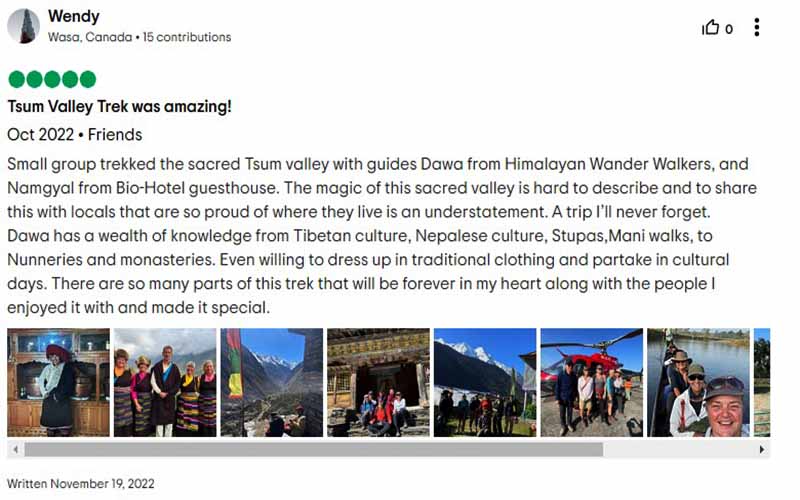
Review Title: Tsum Valley Trek Was Amazing!
Manaslu Trek date: October 2022
Small group trekked the sacred Tsum valley with guides Dawa from Himalayan Wander Walkers, and Namgyal from Bio-Hotel guesthouse. The magic of this sacred valley is hard to describe and to share this with locals that are so proud of where they live is an understatement. A trip I’ll never forget.
Dawa has a wealth of knowledge from Tibetan culture, Nepalese culture, Stupas,Mani walks, to Nunneries and monasteries. Even willing to dress up in traditional clothing and partake in cultural days. There are so many parts of this trek that will be forever in my heart along with the people I enjoyed it with and made it special.
Wendy,
(Canada)
Read our More reviews here: TripAdviser/hwwtreks